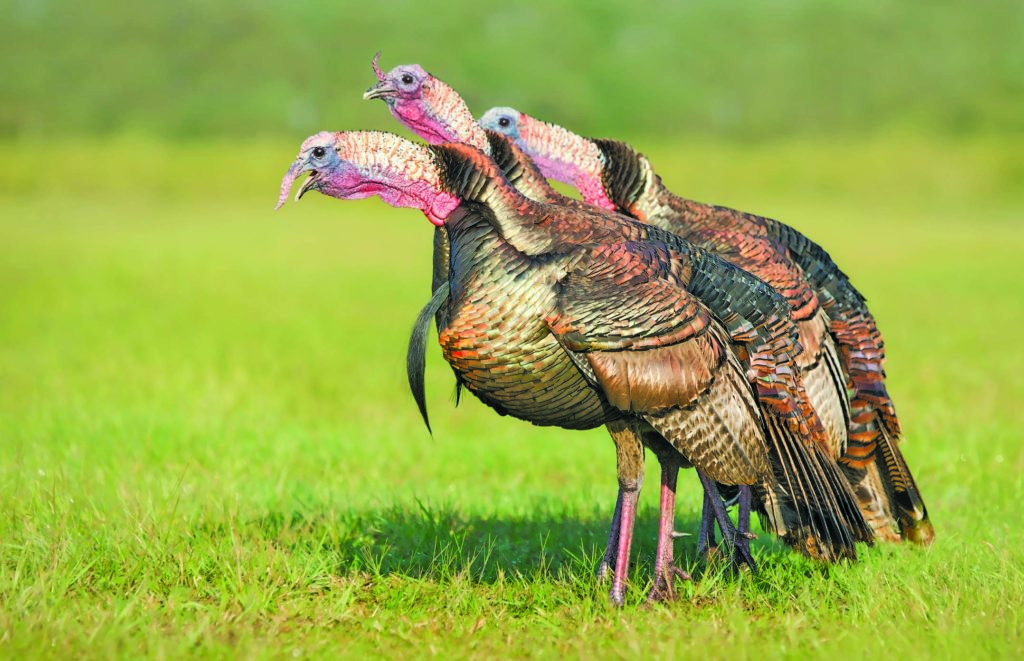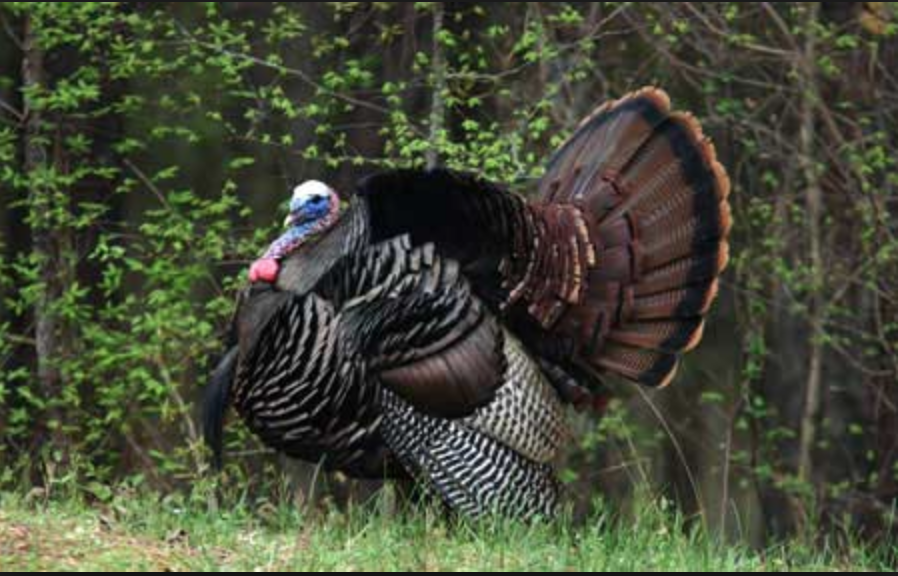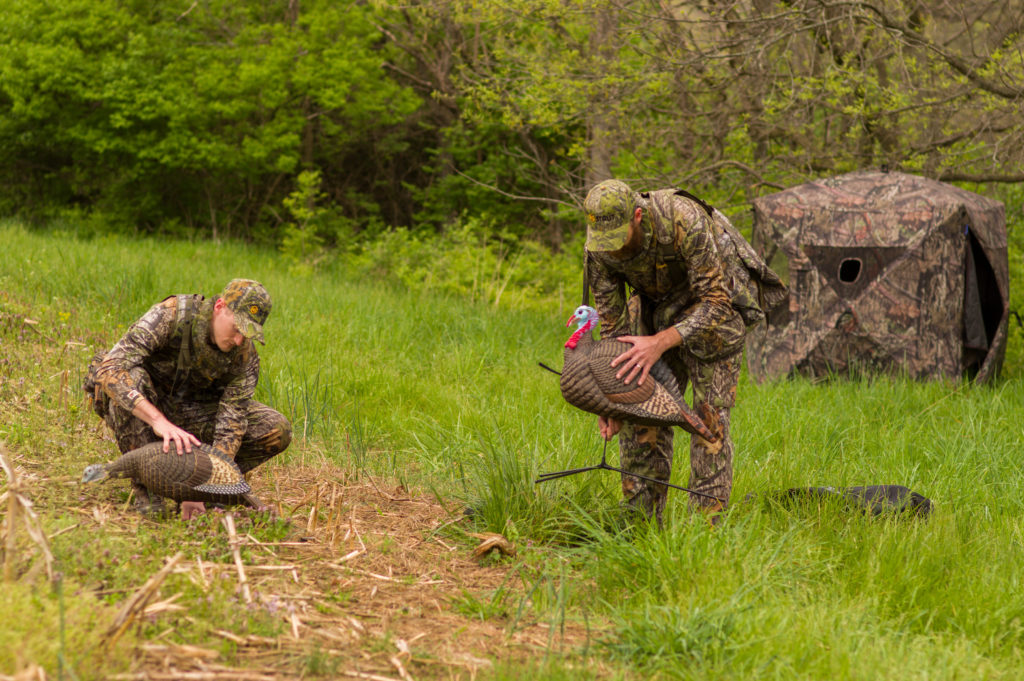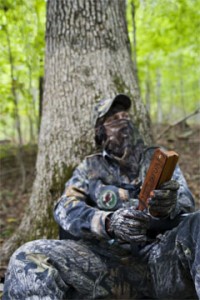By Jim Schlender
Many turkey hunters seem to think that popping up a blind, staking out a couple of dekes and settling into a chair is the best — and only — way to kill a turkey. But my favorite hunts involve a tom searching the woods for a hen he’ll never find.
In the beginning, there was the timber. And then came the turkey. And the hunter. And the call. Put them together, and you had yourself a turkey hunt.
Oh, how things have changed. Sure, “change is constant” and all that, but the numerous twists on our grand old sport seem to have accelerated so greatly during the past dozen years that I think the essence of turkey hunting has changed. It used to be “all about the call,” but now there’s an awful lot of strategies based on, “What you see is what you get.” Or hope to get, anyway.

Three male turkeys size each other up and gobble loudly to attract the attentions of some females nearby.
Maybe it’s all those TV shows we watch in anticipation of spring. Or the DVDs we never tire of watching. Or the countless makes and models of turkey decoys that look more real than the real thing. Or those fancy tent blinds big enough to host a family reunion.
Collectively, they’ve contributed to a widening belief that to kill a turkey, you need to set up out in the open. And that before you can figure out how to get killing-close to a gobbler, you must first lay eyes on him or at least give him something to look at that will bring him your way.
One Example
I have a friend who didn’t join the turkey hunting fraternity until a few years ago, when he was nearly 50. He found success early, and now, predictably, he’s a turkey addict.
He loves all the “stuff” that makes up turkey hunting and, like many of us, goes afield with 20 pounds of gear crammed into his vest. And yes, he owns flocks of decoys and a couple of high-quality blinds.
One afternoon, he was recounting his morning hunt to me. He said he was cozied into his blind in the corner of a 5-acre field, decoys dutifully positioned 20 yards away. Right before flydown, two toms started trading gobbles in the woods behind him. They answered his calling pretty regularly, but within an hour, they had shut up and wandered off.
“I know right where they roost, and I’m pretty sure they head over to a ridge on the neighbor’s property almost every day,” he said, his voice tinged with frustration.
“Great!” I replied. “Are you going to try them again?”
“Yeah, I’m going tomorrow,” he said. “But they’ve done the same thing three days in a row, and I’m really getting tired of it.”
I didn’t want to state the obvious, but I did so politely: “Um, why don’t you set up on the other side of their roost so you can intercept them if they go that away again?”
He considered my suggestion for a moment and then explained: “Nah, it’s too hard to get my blind back in there.”
Hmm.
Whatever it Takes
There’s a generation of turkey hunters who seem to think that popping up a blind, staking out a couple of dekes and settling into a chair is the best — or only — way to kill a turkey. It’s more of a visual vigil than a hunt. Call a little. Or a lot. Or not at all. If you’re in a turkey-rich environment, chances are that most days you’re going to get some action.
TV shows and hunting DVDs reinforce the notion that most turkey hunting happens in places where you can see long distances. And sometimes, that’s the nature of the game. But more often, it’s the need for good video that dictates hunting location and style. After all, who doesn’t enjoy watching an iridescent gobbler showing off for the camera as he works his way across 300 yards of neon-green grass?
But most of us aren’t hunting for the camera. Our goal is to kill a turkey. Sometimes, that means setting up and waiting. Other times, it means aggressive cutting and running. If you’re like me, you’ll do whatever it takes.
Before you start thinking this article is going to turn into a hatchet job on outdoor TV celebrities, decoys, blinds or technology in general, rest assured that it isn’t. I’ve been on a lot of great hunts involving all those — most during several years as editor of this magazine — and every successful outing is burned into my memory like it happened yesterday.
But the hunts that make my heart pound hardest when I think about them are the ones that ended with me pulling the trigger on a tom that was searching the woods for a hen he was never going to find. Deep down, I wish every hunt went like that.
Blind (Lack of) Luck
A few years ago, one of the best callers I’ve ever met invited me to Missouri to hunt his 600-acre lease, a property that was enjoying a booming turkey population that season. He told me how his daughter and wife had killed birds from a blind on the edge of a 20-acre field.
His plan was for us to head into the property extra early so we could get to the blind, set up a decoy and be ready before first light. Then, according to him, it was just a matter of waiting for the right bird to show up.
I like hunting from blinds when it’s raining or I’m tired, or during quiet afternoons when birds aren’t gobbling and there’s nothing else to try. None of those scenarios applied to this situation, so I wasn’t terribly excited about my hunting buddy’s plan. Then again, when in Rome, right? Besides, when you get invited to tag along with someone who’s killed 10 times as many turkeys as you have, you don’t second-guess them.
But then, a funny thing happened on the way to the magical spot: A turkey gobbled. We were cutting through a big piece of timber on our way to the field when a tom thundered right above us. And by right above us, I mean he couldn’t have been more than 60 yards away.
I was ecstatic. This was a gift, and the fact the bird was gobbling meant we hadn’t spooked him. I glanced at my partner, who was just as surprised as I was. I started looking for a tree to set up on. If we could just sit quietly and not give ourselves away, this had potential to be one of those classic kill-him-a-minute-after-flydown hunts we get up so early for.
Uh, not exactly.
“Come on,” my buddy hissed at me. “We’d better get moving so we can get to the blind before daylight.”
That’s right, we left a hard-gobbling tom in the timber so we could go sit in a blind on a field edge and hope for a visit later in the day. Do I even have to finish this story? OK, I’ll keep it short: At 9 a.m., a gobbler entered the field from the same corner we came in on. He stood at 150 yards and eyeballed our lone hen decoy for about two minutes, and then turned and retraced his steps back into the woods.

Boss gobblers often are ornery and finicky, sometimes aggressive, but they’re always fun to tangle with and hunt. (Photo: Bill Garland, USFWS)
A half-hour later, a tom came from the opposite direction, alternately strutting and gobbling as he covered 200 yards in about five minutes. Then, at 60 yards, he stretched his neck as if he was trying to read the patent information on our plastic hen, slicked down into that all-too-familiar “I don’t think I should be here” form, and tip-toed away like a soldier who just realized he’s standing in the middle of a mine field.
Man, I can’t stand a story that doesn’t end with a dead turkey, but that tale is all I went home with that day.
Lessons Learned
This past spring, my son, Jacob, and I drove from Wisconsin to Michigan’s Upper Peninsula to hunt with our friend Pat Muffler, a field-staffer for Hunter’s Specialties. Muffler seems to know every square inch of the U.P., and best, he seems to know everyone who lives there, including the folks with properties big and small that hold lots of turkeys.
Muffler dumped us off outside a farmyard somewhere north of Escanaba the first morning.
“This place is 40 acres, about half of it woods,” Muffler said, gesturing off into the inky darkness. “I have no idea where to suggest you set up, but I can tell you there were at least a couple of birds gobbling in here last week. I’d just get in there and listen for a tom to crank up and then see what happens.”
Jacob and I made our way into a little triangle of woods and waited … and waited some more. A half-hour after daylight, we were still listening for our first gobble. Not wanting to stumble around on a property we didn’t know and risk spooking birds, we set up a pair of decoys off a point of the woods and settled in. Almost three hours later, there we still sat.
“Come on,” I said. “Let’s go look around so at least we know the lay of the land. Then we’ll go grab some breakfast and see if Pat has another spot for us to try.”
We were hiking across a clearing when a turkey gobbled, ever so faintly. At first I dismissed it. No way was the bird even in our zip code. And because we were limited to our 40-acre parcel, it wasn’t like we could take off after him.
We continued across the field toward a 2-acre patch of woods, and just as we reached the edge, the tom rattled again. Closer? Maybe.
“Hmm, let’s try him,” I said to Jacob, though I only half-believed the tom would even hear my loudest box call.
I cranked out a series of raspy yelps. Nothing. Again. Nothing.
“Figures,” I said with a shrug. “Let’s go see what’s on the other side of this little woods.”
We picked our way through the tangled ground clutter, headed nowhere in particular, when the bird hammered again, and although I tried to convince myself he had closed the gap, he still sounded depressingly distant.
More out of habit than the belief the bird was really looking for us, I grabbed my glass call and half-heartedly scratched out a few notes. By some sort of miracle, the bird gobbled back instantly, but dang it, he still sounded impossibly far.
My first thought was to creep to the far side of the woods and try to get a glimpse of the tom out in the fallow field.
“Probably with hens,” I thought, judging by his sporadic gobbling and lukewarm responses to my calls. Maybe I could belly-crawl into the field and put up a decoy.
But before we moved, something —too many wasted days trying that tactic with no results — told me to try him one more time. I’d barely touched my striker to the slate when the bird cut me off. No more playing coy. He was 100 yards, max. If he wasn’t already in the timber with us, he was pretty close to it. Where he would go next, I wasn’t sure, but there was no time to do anything but sit.
“Jacob!” I hissed, pointing to the nearest tree. “Sit! Right there.”
My son complied but then hissed back at me, not entirely without disgust: “Which way am I supposed to be facing?”
That was a fair question from my 13-year-old, because there was no way of knowing where the bird was going to show up, and we were sitting in a cluttered tangle of viney greenery that gave us visibility of only about 40 yards in any direction.
“Point somewhere to the left,” I whispered. “Maybe he’ll try to come around the side.”
We got our first glimpse of the bird when he was only 50 yards out. He was on a mission to find the hen he knew was there. Other than stopping once to half-strut, he came in like he had a death wish.
Jacob didn’t have to move his gun more than about six inches to finalize his aim when the bird stepped into a tiny opening. I cutt once on a mouth call, the bird raised his head as if he couldn’t believe what he’d just walked into, and Jacob pounded him at 32 steps.
Never Knew
“Dad, how did you know he’d come in that way?” Jacob asked as we stood over the still-flopping 2-year-old.
“Just experience,” I said with a grin. “You’ll get it someday.”
I was kidding, of course, because I didn’t believe the tom would come that far and that fast. And later, I told him it was one of those days where everything worked like it was supposed to.
“That was cool,” he replied. “He never even knew we were there.”
Amen, Jacob. Amen.




